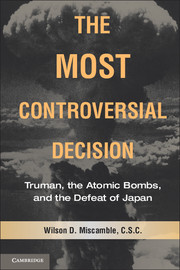Book contents
- Frontmatter
- Contents
- Acknowledgments
- Map 1 The Atomic Bombing of Japan
- Introduction: The Most Controversial Decision
- 1 Franklin Roosevelt, the Manhattan Project, and the Development of the Atomic Bomb
- 2 Harry Truman, Henry Stimson, and Atomic Briefings
- 3 James F. Byrnes, the Atomic Bomb, and the Pacific War
- 4 The Potsdam Conference, the Trinity Test, and Atomic Diplomacy
- 5 Hiroshima, the Japanese, and the Soviets
- 6 The Japanese Surrender
- 7 Necessary, But Was It Right?
- 8 Byrnes, the Soviets, and the American Atomic Monopoly
- 9 The Atomic Bomb and the Origins of the Cold War
- Suggested Readings
- Index
5 - Hiroshima, the Japanese, and the Soviets
Published online by Cambridge University Press: 05 June 2012
- Frontmatter
- Contents
- Acknowledgments
- Map 1 The Atomic Bombing of Japan
- Introduction: The Most Controversial Decision
- 1 Franklin Roosevelt, the Manhattan Project, and the Development of the Atomic Bomb
- 2 Harry Truman, Henry Stimson, and Atomic Briefings
- 3 James F. Byrnes, the Atomic Bomb, and the Pacific War
- 4 The Potsdam Conference, the Trinity Test, and Atomic Diplomacy
- 5 Hiroshima, the Japanese, and the Soviets
- 6 The Japanese Surrender
- 7 Necessary, But Was It Right?
- 8 Byrnes, the Soviets, and the American Atomic Monopoly
- 9 The Atomic Bomb and the Origins of the Cold War
- Suggested Readings
- Index
Summary
The final orders to use the atomic bombs had been issued well before Truman began his journey home from Potsdam. On July 25 General Marshall's deputy, General Thomas Handy, serving as the acting chief of staff, wrote at the direction of Stimson and Marshall to General Carl Spaatz, the commanding general of the Army Strategic Air Forces and told him: “The 509 Composite Group, 20th Air Force will deliver its first special bomb as soon as weather will permit visual bombing after about 3 August 1945 on one of the targets: Hiroshima, Kokura, Niigata and Nagasaki.” Handy went further and instructed that “additional bombs will be delivered on the above targets as soon as ready by the project staff,” and he explained that “further instructions will be issued concerning targets other than those listed above.” Notably, there was no suggestion here that only two bombs would be used. The American military prepared to utilize the atomic weapons as they became available.
Stimson had alerted Truman on July 30 of the rapid progress on what he termed “Grove's project” and the expected use of the atomic bomb in early August. The secretary of war also obtained Truman's approval for the White House to release a prepared statement once the bomb had been delivered on its target. It must be appreciated that the American military largely controlled the specific timing of the bomb's use and Truman proved quite content to delegate that responsibility.
- Type
- Chapter
- Information
- The Most Controversial DecisionTruman, the Atomic Bombs, and the Defeat of Japan, pp. 79 - 93Publisher: Cambridge University PressPrint publication year: 2011



